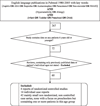Nonsteroidal anti-inflammatory drug hypersensitivity in preschool children
- PMID: 20525116
- PMCID: PMC2873607
- DOI: 10.1186/1710-1492-3-4-114
Nonsteroidal anti-inflammatory drug hypersensitivity in preschool children
Abstract
: Although extensively studied in adults, nonsteroidal anti-inflammatory drug (NSAID) hypersensitivity in children, especially in young children, remains poorly defined. Pediatricians, prescribing antipyretics for children, rarely encounter significant problems, but the few epidemiologic studies performed show conflicting results. Although it is clear that some patients with acetylsalicylic acid (ASA)-sensitive asthma have their clinical onset of disease in childhood and bronchoconstriction after ASA challenge is seen in 0 to 22% of asthmatic children so challenged, ibuprofen at antipyretic doses may cause acute respiratory problems only in a very small number of mild to moderate asthmatics. The recently elucidated mechanism of action of acetaminophen may explain some occurrences of adverse reactions in patients with cross-reactive NSAID hypersensitivity on the basis of its inhibitory activity on the newly described enzyme, cyclooxygenase (COX)-3. This nonspecific sensitivity to inhibition of COX is most likely genetically determined and shows a remarkable association with atopic disease even in the very young age group and possibly an increased predilection in specific ethnic groups. This review summarizes state-of-the-art published data on NSAID hypersensitivity in preschool children.
Figures



Similar articles
-
Early presentation with angioedema and urticaria in cross-reactive hypersensitivity to nonsteroidal antiinflammatory drugs among young, Asian, atopic children.Pediatrics. 2005 Nov;116(5):e675-80. doi: 10.1542/peds.2005-0969. Epub 2005 Oct 17. Pediatrics. 2005. PMID: 16230465
-
Hypersensitivity to cyclooxygenase inhibitory drugs in children: a study of 164 cases.Eur J Dermatol. 2008 Sep-Oct;18(5):561-5. doi: 10.1684/ejd.2008.0480. Epub 2008 Aug 8. Eur J Dermatol. 2008. PMID: 18693161
-
[Special features of NSAID intolerance in children].Allergol Immunopathol (Madr). 2003 May-Jun;31(3):109-25. doi: 10.1016/s0301-0546(03)79277-5. Allergol Immunopathol (Madr). 2003. PMID: 12783761 Review. Spanish.
-
Impact of antipyretics on acute asthma exacerbation during respiratory infection-A nationwide population-based study.Pediatr Neonatol. 2020 Oct;61(5):475-480. doi: 10.1016/j.pedneo.2020.03.018. Epub 2020 Apr 4. Pediatr Neonatol. 2020. PMID: 32331972
-
Risks and benefits of nonsteroidal anti-inflammatory drugs in children: a comparison with paracetamol.Paediatr Drugs. 2001;3(11):817-58. doi: 10.2165/00128072-200103110-00004. Paediatr Drugs. 2001. PMID: 11735667 Review.
Cited by
-
Anaphylaxis to ibuprofen in a 12-year-old boy.BMJ Case Rep. 2013 Jan 14;2013:bcr2012007873. doi: 10.1136/bcr-2012-007873. BMJ Case Rep. 2013. PMID: 23322307 Free PMC article.
-
Tolerance to etoricoxib in children with nonsteroidal anti-inflammatory drug hypersensitivity.Asia Pac Allergy. 2015 Jan;5(1):40-6. doi: 10.5415/apallergy.2015.5.1.40. Epub 2015 Jan 28. Asia Pac Allergy. 2015. PMID: 25653919 Free PMC article.
-
Ibuprofen-induced Anaphylactic Shock in Adult Saudi Patient.Cureus. 2019 Dec 20;11(12):e6425. doi: 10.7759/cureus.6425. Cureus. 2019. PMID: 31993263 Free PMC article.
-
Balancing the risks and benefits of the use of over-the-counter pain medications in children.Drug Saf. 2012 Dec 1;35(12):1119-25. doi: 10.1007/BF03261998. Drug Saf. 2012. PMID: 23078168 Review.
-
Anti-Asthma Effect of an Active Components Group from Decoction of Pheretima Aspergillum and Its Chemical Composition Characterized by Liquid Chromatography-Quadrupole Time of Flight Mass Spectrometry.Iran J Pharm Res. 2019 Spring;18(2):867-876. doi: 10.22037/ijpr.2019.1100666. Iran J Pharm Res. 2019. PMID: 31531069 Free PMC article.
References
-
- Aspirin and Reye syndrome. Committee on Infectious Diseases. Pediatrics. 1982;69:810–2. - PubMed
-
- Drug and Device Approvals - March 1995. U.S. Food and Drug administration, Center for Drug Evaluation and Research; 1995.
-
- Stevenson DD, Simon RA, Zuraw BL. In: Adkinson: Middleton's Allergy, Principles and Practice. 6. Elliott Middleton J, Charles E Reed, Elliot F Ellis, N Franklin Adkinson J, John W Yunginger, William W Busse, editor. Mosby Inc; 2003. Sensitivity to Aspirin and Nonsteroidal Anti-inflammatory Drugs; p. 1695.
LinkOut - more resources
Full Text Sources

